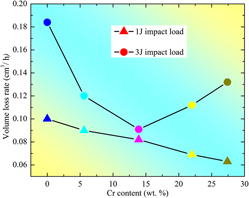Crossref Citations
This article has been cited by the following publications. This list is generated based on data provided by
Crossref.
Zhong, Lisheng
Yan, Yinglin
Ovcharenko, Vladimir E.
Cai, Xiaolong
Zhang, Xi
and
Xu, Yunhua
2015.
Microstructural and Mechanical Properties of In Situ WC-Fe/Fe Composites.
Journal of Materials Engineering and Performance,
Vol. 24,
Issue. 11,
p.
4561.
Zhong, Lisheng
Zhang, Xi
Chen, Shili
Xu, Yunhua
Wu, Hong
and
Wang, Juan
2016.
Fe–W–C thermodynamics and in situ preparation of tungsten carbide-reinforced iron-based surface composites by solid-phase diffusion.
International Journal of Refractory Metals and Hard Materials,
Vol. 57,
Issue. ,
p.
42.
Li, Zulai
Wang, Pengfei
Shan, Quan
Jiang, Yehua
Wei, He
and
Tan, Jun
2018.
The Particle Shape of WC Governing the Fracture Mechanism of Particle Reinforced Iron Matrix Composites.
Materials,
Vol. 11,
Issue. 6,
p.
984.
Sui, Yudong
Han, Lina
Jiang, Yehua
Li, Zulai
and
Shan, Quan
2018.
Effects of Ni60WC25 powder content on the microstructure and wear properties of WCp reinforced surface metal matrix composites.
Transactions of the Indian Institute of Metals,
Vol. 71,
Issue. 10,
p.
2415.
Grairia, A
Beliardouh, N E
Zahzouh, M
Nouveau, C
and
Besnard, A
2018.
Dry sliding wear investigation on tungsten carbide particles reinforced iron matrix composites.
Materials Research Express,
Vol. 5,
Issue. 11,
p.
116528.
Zheng, Baochao
Li, Wei
Tu, Xiaohui
Song, Suocheng
and
Huang, Wenjun
2019.
Effect of ZTA ceramic particles strengthened high chromium white cast iron on three-body abrasion behavior.
Materials Research Express,
Vol. 6,
Issue. 11,
p.
116581.
Shan, Quan
Zhou, Zaifeng
Li, Zulai
Jiang, Yehua
Gao, Fan
and
Zhang, Lei
2019.
Effect of oxidation on thermal fatigue behavior of cast tungsten carbide particle/steel substrate surface composite.
Journal of Materials Research,
Vol. 34,
Issue. 10,
p.
1754.
Pan, Yafei
Liu, Aijun
Huang, Lei
Du, Yong
Jin, Yaqin
Yang, Xinyu
and
Zhang, Jiuxing
2019.
Effects of metal binder content and carbide grain size on the microstructure and properties of SPS manufactured WC–Fe composites.
Journal of Alloys and Compounds,
Vol. 784,
Issue. ,
p.
519.
Moreira, Aida B.
Ribeiro, Laura M. M.
Lacerda, Pedro
Sousa, Ricardo O.
Pinto, Ana M. P.
and
Vieira, Manuel F.
2020.
Preparation and Microstructural Characterization of a High-Cr White Cast Iron Reinforced with WC Particles.
Materials,
Vol. 13,
Issue. 11,
p.
2596.
Moreira, Aida B.
Sousa, Ricardo O.
Lacerda, Pedro
Ribeiro, Laura M. M.
Pinto, Ana M. P.
and
Vieira, Manuel F.
2020.
Microstructural Characterization of TiC–White Cast-Iron Composites Fabricated by In Situ Technique.
Materials,
Vol. 13,
Issue. 1,
p.
209.
Zhang, DongLan
Li, ZuLai
Shan, Quan
Jiang, YeHua
Feng, Jing
and
Chong, XiaoYu
2020.
Thermodynamic analysis of the interface reaction and thermal stress of WCp/Fe composites.
Ceramics International,
Vol. 46,
Issue. 16,
p.
26210.
Kostryzhev, A.G.
Killmore, C.R.
Yu, D.
and
Pereloma, E.V.
2020.
Martensitic wear resistant steels alloyed with titanium.
Wear,
Vol. 446-447,
Issue. ,
p.
203203.
Li, Zulai
Zhao, Wei
Zhang, Donglan
Shan, Quan
Zhang, Fei
and
Wang, Xingyu
2021.
Influence of rare-earth element doping on interface and mechanical properties of WC particles reinforced steel matrix composites.
Materials Research Express,
Vol. 8,
Issue. 3,
p.
036512.
Moreira, Aida B.
Ribeiro, Laura M. M.
and
Vieira, Manuel F.
2021.
Production of TiC-MMCs Reinforcements in Cast Ferrous Alloys Using In Situ Methods.
Materials,
Vol. 14,
Issue. 17,
p.
5072.
Jing, Zhenwei
Yan, Hongyan
Xu, Yanke
Li, Hui
and
Liang, Jinglong
2022.
TMS 2022 151st Annual Meeting & Exhibition Supplemental Proceedings.
p.
609.
Shabalin, Igor L.
2022.
Ultra-High Temperature Materials IV.
p.
11.
Zhao, Nana
Yao, Teli
Wang, Zihan
Shan, Rui
Ren, Congcong
Liu, Heguang
Li, Shujuan
Xu, Yunhua
and
Cui, Zhen
2023.
Thermal/kinetic study of the formation mechanism of NbC-Fe composite layer on the surface of GCr15 prepared by hot pressure diffusion.
Materials Research Express,
Vol. 10,
Issue. 4,
p.
046401.
Wu, Kejun
Zhang, Zhanzhan
Liao, Haiyang
Sun, Xiao
and
Yu, Liu
2023.
First principles calculation of interfacial stability, electronic and mechanical properties of WC-304 cemented carbides.
International Journal of Refractory Metals and Hard Materials,
Vol. 117,
Issue. ,
p.
106407.
Ebert, Fabian
Ingale, Piyush
Vogl, Sarah
Praetz, Sebastian
Schlesiger, Christopher
Pfister, Nils
Naumann d’Alnoncourt, Raoul
Roldán Cuenya, Beatriz
Thomas, Arne
Gioria, Esteban
and
Rosowski, Frank
2024.
Cobalt(II) Nanoclusters Incorporated in Ordered Mesoporous Al2O3 for Stable and Coke-Resistant Propane Dehydrogenation.
ACS Catalysis,
Vol. 14,
Issue. 13,
p.
9993.
Alkraidi, Ammar Basil Nader
Mansoor, Mubashir
Boztemur, Burçak
Gökçe, Hasan
Kaya, Faruk
Yıldırım, Cennet
Derin, Bora
Ağaoğulları, Duygu
and
Öveçoğlu, M.Lütfi
2024.
Computational alloy design, synthesis, and characterization of WMoNbVCrx refractory high entropy alloy prepared by vacuum arc melting.
Journal of Alloys and Compounds,
Vol. 1003,
Issue. ,
p.
175510.



